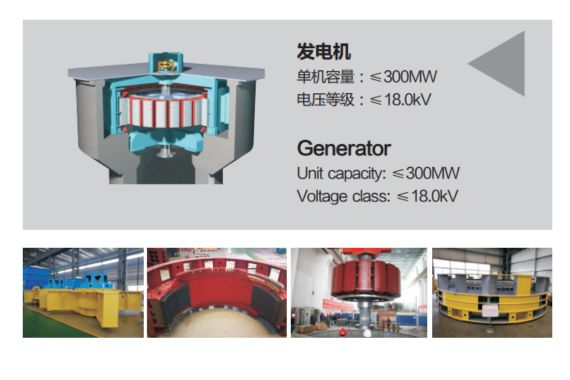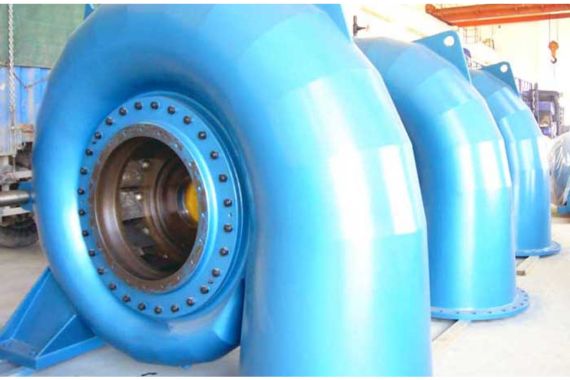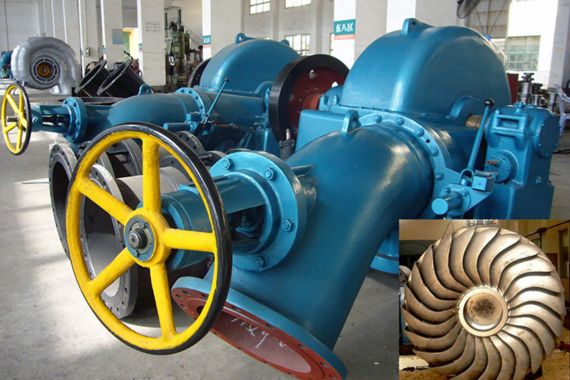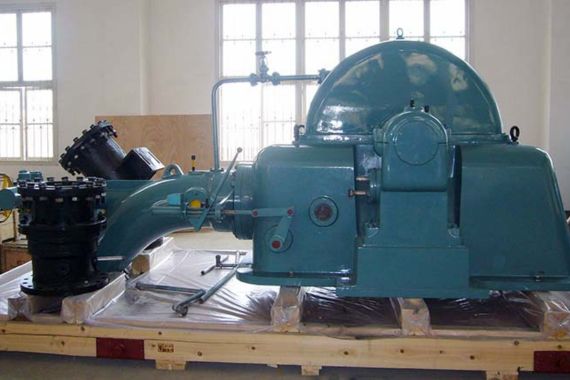A hydroelectric power plant is an industrial enterprise that uses the kinetic energy of the strong water flow generated by the water level difference to generate electricity, It is an industrial enterprise that uses the water energy of a river to drive a turbine to drive a generator set. Although hydroelectric power plants have high infrastructure investment and long construction cycles, they have advantages such as no need for fuel, low cost, no environmental pollution, and simple manufacturing of mechanical and electrical equipment. Moreover, their power generation hydraulic structures can be combined with flood control, irrigation, water supply, shipping, aquaculture and other industries to achieve comprehensive utilization of water resources.

In 1833, a Swedish chemist predicted that hydroelectric power would become a sustainable and renewable source of electricity. In 1878, single household hydroelectric power applications emerged in Northumberland, England. In the same year, Francis built the first hydro power station around the world. In 1879, Henry Menier first applied hydroelectric power to agricultural production. The following year, commercial hydroelectric power generation with multiple users emerged in the Michigan Rapids section. In 1882, Thomas Edison built another hydro power plant in Appleton, Wisconsin, which is regardsed as the earliest hydro power plant in the world. In 1912, China used German technology to build its first hydroelectric power station in Kunming – Shilongba Hydroelectric Plant; In the past 30 years, China’s hydropower development was mainly commercial in nature. After the establishment of the People’s Republic of China, it gradually shifted to livelihood projects and gradually gained a leading position globally. A notable example is the Three Gorges Project, which began construction in 1994.
A hydroelectric power plant consists of hydraulic structures, fluid machinery, hydraulic metal components and electrical systems, including a power transmission line to connect with local power grid network and a complicated electrical distribution system. . Its working principle is that the water flow impacts the water turbine, causing it to rotate, thereby converting kinetic energy into mechanical energy, and then the water turbine drives the generator to rotate, generating electrical energy. In addition, hydroelectric power stations can be classified in various ways, such as conventional hydroelectric power stations, pumped storage power stations, and tidal power stations based on the nature of the water source; According to the development method, it can be divided into dam type hydropower stations, diversion type hydropower stations, and hybrid hydropower stations; According to the size of the utilized water head, it can be divided into high head, medium head, and low head hydropower stations; According to the installed capacity, hydroelectric power plants can be divided into large, medium, and small ones.
A Brief History of Hydroelectric Power Plant
Hydroelectric power has a long history, initially relying on hydraulic machinery driving devices to reduce labor. By the 1930s, with the emergence of hand cranked electromagnetic machines, scientists gradually gained a deeper understanding of the transformation of water resources. In 1833, a Swedish chemist predicted that hydroelectric power would become a sustainable and reusable power resource. In 1878, a single household hydroelectric power application emerged in Northumberland, England. At that time, William Armstrong, with his wealth and professional knowledge, pioneered the use of hydroelectric power to light up the first arc lamp. In 1878, France built the world’s first hydroelectric power station. In 1879, Henry Menier first applied hydroelectric power to agriculture, and the following year, commercial hydroelectric power with multiple users emerged in the Michigan Rapids. In 1882, Edison established the hydroelectric power system in Appleton, Wisconsin, which is considered the world’s earliest hydroelectric power station. The first hydroelectric power station in China appeared in 1912, and in the following nearly 30 years, China’s hydroelectric development was mainly commercial in nature, gradually shifting to livelihood projects after the establishment of the People’s Republic of China, and achieving a leading position. For example, the Three Gorges Project, which started construction in 1994, is a typical example.
Operational principle of a Hydroelectric Power Plant
The basic principle of hydroelectric power generation is to use the height difference (head) of the water flow to drive the rotation of the water turbine, converting the potential energy of the water flow into mechanical energy. When the water turbine is connected to the generator, its rotation drives the generator to generate electricity, thereby converting mechanical energy into electrical energy. Therefore, hydroelectric power generation is essentially the process in which the potential energy of water is converted twice, first into mechanical energy, and then into electrical energy.
Hydroelectric power plants, are a complete set of engineering facilities that convert water energy into electricity. This includes various buildings and equipment built for power generation purposes. Through these buildings, such as dams and reservoirs, natural water flow can be concentrated and regulated, and necessary water heads can be formed. The water flow is guided to the water turbine, and the coordinated work of the turbine and generator converts water energy into electrical energy. Subsequently, electricity is transmitted to the grid through transformers, switchyards, and transmission lines. Many hydroelectric power plants, in addition to the necessary facilities for power generation, also include buildings that serve various purposes such as flood control, irrigation, navigation, logging, and fishing. The collection of these comprehensive facilities is called a hydroelectric power station hub or water conservancy hub.
Basic structure of Hydroelectric Power Plant
A hydroelectric power station consists of hydraulic structures, fluid machinery, electrical systems, and hydraulic metal components.
Hydraulic structures
Underwater structures include water retaining structures, water diversion structures, discharge structures, and hydroelectric power plant buildings (power generation structures).
(1) Water retaining structures: form low dams, maintain high water levels, and become reservoirs with regulating capabilities. The pier dams in water retaining structures are further divided into flat plate dams, multi arch dams, and large head dams. Earth rock material dams are divided into earth dams, rockfill dams, and mixed stone dams. According to the different materials used for dam construction, it can be mainly divided into two categories: concrete dams and earth rock dams. Concrete dams can be divided into gravity dams, arch dams, pier dams, and roller compacted concrete dams.
(2) Diversion structure: a building that diverts water to a hydroelectric power plant, including an inlet, diversion channel (or tunnel), pressure forebay (or regulating chamber), pressure pipelines, etc.
(3) Water release structures: Control the flood operating water level during the flood season, flush sand, discharge ice, and empty the reservoir, allowing upstream water to be directly released downstream without passing through the power station. There are overflow dams, spillway channels, discharge gates, discharge tunnels, and dam body discharge holes.
(4) Hydroelectric power plant buildings: According to their structural and layout characteristics, they are divided into surface type buildings, underground type buildings, dam type buildings, and overflow type buildings.

Water retaining structures
Fluid Machinery
The main body of fluid machinery is a water turbine, which converts water flow energy into rotating mechanical energy, and then converts mechanical energy into electrical energy through a generator. The auxiliary equipment of fluid machinery includes speed controllers and oil pressure devices, as well as auxiliary equipment required to meet the normal operation, installation, and maintenance of the main engine, such as inlet valves, lifting equipment, technical water supply systems, maintenance drainage systems, leakage drainage systems, turbine oil systems, insulation oil systems, compressed air systems, hydraulic measurement systems, mechanical maintenance equipment, etc.
The electrical system includes electrical primary, electrical secondary, and communication.
(1) Electrical primary: It has the function of generating, transforming, distributing, and outputting electrical energy. On the basis of the determined connection method between the power station and the power system, the main electrical wiring is used as the main body, and it forms a whole with the auxiliary power wiring, overvoltage protection, grounding, lighting and other systems. The main electrical equipment of the electrical system includes generators, main power transformers, circuit breakers, converter equipment, plant transformers, parallel reactors, arc suppression coils, grounding transformers, isolating switches, transformers, lightning arresters, busbars, cables, etc.
(2) Electrical secondary: measure, monitor, control, and protect the mechanical and electrical equipment of the entire plant to ensure that the power station can safely, reliably, and economically emit electrical energy that meets quality requirements. In the event of abnormalities or accidents in the mechanical and electrical equipment, signals or automatically cut off faults to narrow the scope of accidents. The system mainly includes automatic control, relay protection, as well as secondary wiring, signal, electrical measurement, etc.
(3) Communication is an important means to ensure the safe operation, production management, and economic dispatch of hydroelectric power plants. Under all circumstances, it is required to be unobstructed.
Hydraulic metal components
Hydraulic metal components generally include pressure steel pipes, trash racks, cleaning equipment, gates, and opening and closing equipment. These metal components can be used for blocking, cleaning, blocking water, diverting water, sand, regulating flow, and isolating water bodies during equipment maintenance. Hydraulic metal components are an integral part of hydraulic structures. [5]
Basic classifications of a hydroelectric power plant
Classification by water source nature
Conventional hydroelectric power plants
Conventional hydroelectric power plants, also known as dam type hydroelectric power plants or reservoir type hydroelectric power plants, are facilities that utilize natural rivers, lakes, and other water sources for power generation. Its working principle is to form a reservoir by constructing embankments, utilizing the water in the reservoir to store a large amount of gravitational potential energy. When the water flows out through the outlet on one side of the dam, the height difference between it and the reservoir level forms the head, head, or head, which is a key factor in converting water energy into electricity.

Conventional hydroelectric power plants
Pumped storage power station
The basic structure of a pumped storage power station includes an upper reservoir, a lower reservoir, a water conveyance system, a factory building, and other specialized buildings. Pumped storage power stations utilize the excess electricity during low load periods in the power grid to pump water from lower reservoirs to higher reservoirs for storage. When the power grid load reaches its peak, they release water for power generation, and the tail water flows to the lower reservoir to meet the needs of power grid peak regulation and other power loads. [3] In addition, pumped storage power stations are currently the most commonly used large-scale energy storage technology, mainly used for peak shaving and valley filling in power systems, frequency modulation and phase modulation, and emergency backup. Pumped storage power stations have advantages such as mature technology, high efficiency, large capacity, and unrestricted energy storage cycles. However, pumped storage power stations require suitable geographical conditions to build reservoirs and dams, while also having disadvantages such as long construction cycles and huge initial investment. Usually, pumped storage power stations are divided into two categories based on the presence or absence of natural runoff: one is a pure pumped storage power station, where the upper reservoir has little or no natural runoff, and the water is recycled between the upper and lower reservoirs. It mainly undertakes tasks such as peak shaving, valley filling, and emergency backup, rather than conventional power generation; The second is a hybrid pumped storage power station, which has natural runoff from the upper reservoir. It not only uses natural runoff to undertake tasks such as conventional power generation and comprehensive utilization of hydropower, but also undertakes tasks such as peak shaving and valley filling, and emergency backup.
Pumped storage power station
Tidal power station
Tidal power generation is a type of hydroelectric power generation. Building dams, gates, and factories in conditional bays or tidal mouths to enclose reservoirs, creating a certain tidal range (i.e. working head) between the reservoir water level and the offshore tide level, which can drive hydroelectric generators to generate electricity. [12] According to the utilization and regulation capacity of natural water flow in hydroelectric power plants, they can be divided into two categories. 1. Runoff type hydroelectric power station: a hydroelectric power station with no reservoir or very small reservoir capacity, and no or very small regulation capacity for natural water volume; 2. Storage type hydroelectric power station: a hydroelectric power station with a certain reservoir capacity and different regulating capabilities for natural water flow. [3]
Tidal hydroelectric power station
Classified by development method
Dam type hydroelectric power station
Dam type hydropower stations are built by constructing dams or gates on the river, artificially raising the water level to form a water flow drop, and then using water pipelines or tunnels to guide the water in the reservoir to the power plant. In the factory building, the water turbine generator unit converts water energy into electrical energy. According to the layout of the factory building, dam type hydropower stations can be divided into two types: riverbed type and dam rear type. The factory building of a riverbed type hydropower station is directly located on the riverbed or channel, arranged in a straight line or at a certain angle with the dam or water gate. In this case, the factory building itself becomes a part of the dam or gate body, jointly bearing the water pressure. This design is common in plain areas and is suitable for hydropower stations with low water heads, or in water diversion and irrigation channels with drop. On the other hand, the powerhouse of the dam type hydropower station is located downstream of the dam and is built separately from the dam body. In this configuration, the factory building does not bear the function of water blocking or water pressure. This design is more suitable for hydropower stations with higher water heads, as it allows for a larger water flow drop, thereby improving power generation efficiency.
River bed hydroelectric power station
Diversion type hydropower station
A diversion type hydropower station diverts river water to a downstream channel at a certain distance from the inlet by constructing a diversion channel, such as a channel or tunnel. This method forms a water level difference, also known as head, between the diversion channel and the downstream river channel. The power plant building is usually built on the bank of the downstream river channel. According to the characteristics of water flow in the diversion channel, diversion hydropower stations can be divided into two types: non pressurized diversion and pressurized diversion. The water flow in the diversion channel of a non pressure diversion hydropower station has no pressure, while the water flow in the diversion channel of a pressure diversion hydropower station is in a pressure state. The construction of diversion type hydropower stations is usually more advantageous in the following situations: when the original river slope is steep, there are natural waterfalls or severe river bends. A low dam is usually built at the water inlet, whose main function is not to increase water head or form a reservoir to regulate flow, but to intercept water flow and facilitate water intake. In practical engineering practice, non pressure diversion hydropower stations are more common in small hydropower stations. This type of hydropower station is suitable for situations where the upstream water level does not change significantly. On the contrary, when the upstream water level changes significantly, a pressurized water diversion hydropower station is more suitable because it can better adapt to changes in water level and maintain a stable water supply.
Non pressure diversion hydroelectric power station
Hybrid hydropower station
A hybrid hydropower station combines the characteristics of a dam type hydropower station and a diversion type hydropower station. In this type of hydropower station, a portion of the water head is obtained through the construction of a dam, while the other portion is achieved through a diversion channel. This design can not only take advantage of natural geographical conditions such as curved rivers and steep water drops, but also regulate river water flow through reservoirs to meet different power generation needs. The construction of hybrid hydropower stations usually requires comprehensive consideration of multiple factors, including terrain, hydrological conditions, environmental impacts, and economic benefits. Through this approach, hybrid hydropower stations can achieve more efficient and flexible electricity production, while also better adapting to natural hydrological changes, ensuring the stability and reliability of electricity supply.
Hybrid hydroelectric power station
Classified by the size of water head utilization
Power plants can be classified into high head, medium head, and low head hydropower stations based on the utilized head (i.e. the height difference when water flows from the reservoir to the turbine). There is no unified regulation on the specific division of water head in the world. Some countries consider low head hydropower stations with a water head lower than 15m, medium head hydropower stations with a water head of 15-70m, high head hydropower stations with a water head of 71-250m, and ultra-high head hydropower stations with a water head greater than 250m. In China, it is commonly referred to as a low head hydroelectric power station with a water head below 30m, a medium head hydroelectric power station with a water head of 30-70m, and a high head hydroelectric power station with a water head greater than 70m. This classification standard is suitable for the classification of the main buildings of hydroelectric power plants and the scope of application of the classification of hydroelectric generator units.
Low head hydroelectric power station
Classified by installed capacity
Hydroelectric power plants can be classified into three categories based on their installed capacity: large, medium, and small. Internationally, hydroelectric power plants with an installed capacity of no more than 5000 kilowatts are generally classified as small hydroelectric power plants, those with an installed capacity of 5000 to 100000 kilowatts are classified as medium-sized hydroelectric power plants, and those with an installed capacity of 100000 to 1 million kilowatts are classified as large hydroelectric power plants. Those with an installed capacity exceeding 1 million kilowatts are classified as giant hydroelectric power plants. In China, hydroelectric power plants are classified into five levels. Those with an installed capacity exceeding 750000 kilowatts are considered as first-class large-scale hydroelectric power plants, those with an installed capacity of 750000 to 250000 kilowatts are classified as second-class large-scale hydroelectric power plants, those with an installed capacity of 250000 to 25000 kilowatts are classified as third class medium-sized hydroelectric power plants, those with an installed capacity of 25000 to 500 kilowatts are classified as fourth class small-scale hydroelectric power plants, and those with an installed capacity of less than 500 kilowatts are classified as fifth class small-scale hydroelectric power plants. However, in statistics, power plants below 12000 kilowatts are generally considered as small-scale hydropower stations.
Small hydropower stations
Characteristics of power plants
An endless cycle of water energy
Water in nature evaporates from solar radiation and becomes water vapor. When it takes off, it forms an airflow, which condenses into rain or snow when it encounters cold air. When it falls to the ground, it flows into rivers and oceans, and the water in nature circulates continuously in the atmosphere. Therefore, from a certain perspective, water sources are inexhaustible and inexhaustible. Using hydropower as the energy source for hydroelectric power generation can be continuously recycled. Compared with thermal power generation, it does not require a large amount of energy resources such as coal, oil, or natural gas, which cannot be compared with other energy resources such as hydropower.
Comprehensive utilization of water resources
Water resources have various utility values, such as building a reservoir, which not only generates electricity but also has functions such as flood control, irrigation, navigation, aquaculture, improving the environment, and forming tourist attractions. The water resources of rivers can also be developed in a cascade manner, where the upstream water flows into the downstream after being diverted and generated by hydroelectric power plants, and can be reused in various levels of hydroelectric power plants downstream.
Water energy resource regulation and storage
The production and consumption of electricity occur simultaneously, so it is not possible to store a large amount of electricity. On the contrary, hydroelectric power stations can use the construction of reservoirs to store and regulate water energy, instead of storing and storing electricity, which is conducive to the balance of supply and demand in the power system, improving the flexibility and economy of power supply.

Hydroelectric units have greater flexibility
The hydroelectric generator unit of a hydroelectric power station has the advantages of simple equipment, flexible operation, and easy automation. It can be quickly started and put into operation within a few minutes (4-5 minutes under normal conditions, and about 1 minute in emergency situations), and it is also very convenient to increase or decrease the load. Therefore, water turbine units can usually undertake tasks such as peak shaving, frequency regulation, and emergency standby in the power system. Although thermal power units can also achieve the above tasks, there are problems such as fuel waste due to complex equipment, long start-up time, and frequent need to be in a hot standby state.
High efficiency and low cost
The production efficiency of hydroelectric units is relatively high. The power generation efficiency of large and medium-sized hydroelectric power plants is about 80-90%, while that of small hydroelectric power plants is about 60-70%. However, the power generation efficiency of thermal power plants is only about 35%. At the same time, the cost of hydroelectric power generation is relatively low, generally about 1/3 to 1/4 of that of thermal power.
Hydroelectric power plants do not produce pollution
Thermal power plants emit a large amount of exhaust gas, wastewater, and waste residue during the production process, causing pollution to nearby water bodies and the environment. However, hydroelectric power plants have neither smoke nor waste residue, and there is relatively little wastewater, so they basically do not produce pollution. In addition, the construction of reservoirs can have a certain improvement effect on the local environment and climate.
Long construction period and high cost
Although hydroelectric power stations have many of the above characteristics, they also have shortcomings. The civil engineering of hydroelectric power plants involves a large amount of work, with a higher cost compared to thermal power plants and a longer construction period. Due to the limitations of the dry season, there may also be an imbalance in power generation.
Functional value
Hydroelectric power generation is the pillar of the low-carbon power industry, with a power supply 55% higher than nuclear energy and more than the total amount of other renewable energy sources combined. As of 2024, hydropower has a history of over a hundred years and is a major component of the power industry. The most intuitive benefit is that hydroelectric power solves many energy supply problems. In the past, thermal power consumed a large amount of materials and had high costs, making it difficult to collect and utilize on a large scale. However, hydroelectric power was much easier, and a continuous source of energy could be obtained by combining water level differences with hydroelectric generators. The energy generated was sufficient to supply the entire power supply for daily lighting and industrial production. In addition, hydropower provides a pollution-free renewable energy source with a relatively high utilization rate. The IEA has predicted that the world’s total hydroelectric power generation will increase by nearly 850TWh from 2021 to 2030.
The Chinese economy has entered a new period of development. While the national economy continues to grow rapidly and the process of industrial modernization accelerates, resource and environmental constraints are tightening, energy supply is in a tense situation, and ecological environment pressure continues to increase. Based on this, accelerating the development of hydraulic resources in the western region and achieving the transmission of electricity from the west to the east is undoubtedly of great significance for solving the energy shortage problem in national economic development, improving the ecological environment, promoting regional economic coordination and sustainable development. In addition, vigorously developing the hydropower industry will help narrow the urban-rural gap, improve rural production and living conditions, and play an irreplaceable role in promoting local agricultural production, increasing farmers’ income, accelerating poverty alleviation, promoting ethnic unity, and maintaining social stability. Hydroelectric development, driven by investment, increased taxation, and the development of related service industries, will transform local resource advantages into economic and industrial advantages, thereby driving the development of other industries, forming strong supporting industrial clusters, and effectively promoting the comprehensive development of local economy.
Famous hydropower Plants
Power Station Name
Country
Installed capacity MW
Three Gorges Dam
China
twenty-two thousand and five hundred
Itaipu Dam
Brazil, Uruguay
fourteen thousand
Xiluodu Dam
China
thirteen thousand eight hundred and six
Belo Monte dam
Brazil
eleven thousand two hundred and thirty-three
Guli Dam
Venezuela
ten thousand two hundred and thirty-five
Tukurui Dam
Brazil
eight thousand three hundred and seventy
Daguli Dam
United States
six thousand eight hundred and nine
Xiangjiaba
China
six thousand four hundred and forty-eight
longtan dam
China
six thousand four hundred and twenty-six
Sayansushinsk Hydroelectric Station
Russia
six thousand and four hundred
Statistics deadline: July 5, 2021, r
Technical Trends of a Hydroelectric Power Plant
In the future, with the application of technologies such as digitization and intelligence, hydropower stations will develop towards greater intelligence, efficiency, and safety. In the future, China will also focus on key technologies such as intelligent construction, intelligent equipment, and intelligent management of hydropower stations, actively promote the upgrading of the hydropower industry, further develop clean energy, increase the development of hydropower and new energy, and continuously improve the level of intelligent construction and operation management of hydropower stations.
Facing challenges of Hydroelectric Power Plant
Hydroelectric power plants have the disadvantage of instability, and their construction will cause a certain degree of pollution to the local environment. Therefore, improving the utilization rate of hydropower and solving environmental problems are the two major trends in future hydropower generation. The adoption of pumped storage devices in the hydropower industry can improve power storage and solve the imbalance in the supply and demand time of hydropower. At the same time, striving to develop green hydropower is also an inevitable trend in solving environmental problems at present.
